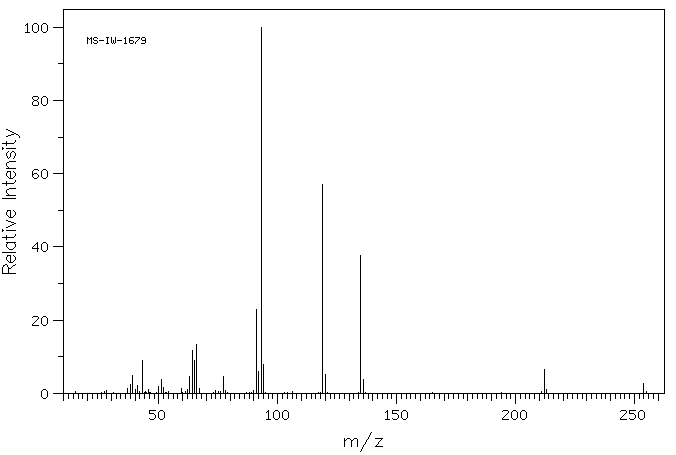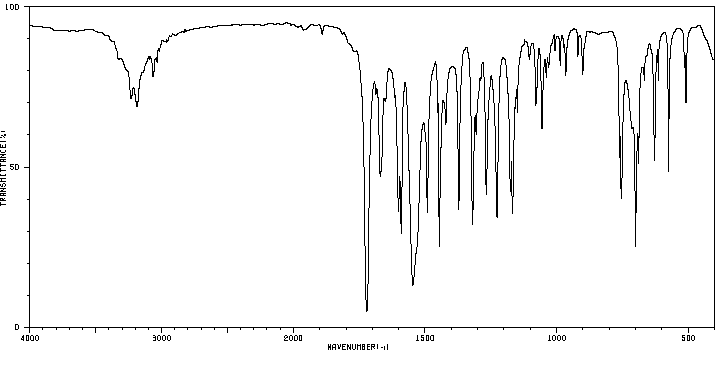methyl α,χ-diphenylallophanate | 39510-74-2
中文名称
——
中文别名
——
英文名称
methyl α,χ-diphenylallophanate
英文别名
N-acetyl-N,N'-diphenylurea;1-acetyl-1,3-diphenylurea;N-acetyl-N,N'-diphenyl-urea;N-Acetyl-N,N'-diphenyl-harnstoff;N-phenyl-N-(phenylcarbamoyl)acetamide
CAS
39510-74-2
化学式
C15H14N2O2
mdl
——
分子量
254.288
InChiKey
VLEBSGBTTVLWGR-UHFFFAOYSA-N
BEILSTEIN
——
EINECS
——
-
物化性质
-
计算性质
-
ADMET
-
安全信息
-
SDS
-
制备方法与用途
-
上下游信息
-
文献信息
-
表征谱图
-
同类化合物
-
相关功能分类
-
相关结构分类
计算性质
-
辛醇/水分配系数(LogP):2.1
-
重原子数:19
-
可旋转键数:2
-
环数:2.0
-
sp3杂化的碳原子比例:0.07
-
拓扑面积:49.4
-
氢给体数:1
-
氢受体数:2
SDS
反应信息
-
作为反应物:参考文献:名称:Busch; Blume; Pungs, Journal fur praktische Chemie (Leipzig 1954), 1909, vol. <2>79, p. 563摘要:DOI:
-
作为产物:描述:manganese triacetate 、 N,N'-二苯基硫脲 以 乙腈 为溶剂, 反应 3.0h, 以72%的产率得到methyl α,χ-diphenylallophanate参考文献:名称:Regioselective synthesis of N-acetylureas by manganese(III) acetate reaction of 1,3-disubstituted thioureas摘要:Reactions of asymmetrical 1,3-disubstituted thioureas with manganese(III) acetate produce regioselective N-acetylureas. A mechanism for this novel transformation is proposed. (c) 2006 Elsevier Ltd. All rights reserved.DOI:10.1016/j.tetlet.2006.02.013
文献信息
-
Mild Acetylation of Amides, Thioamides, Ureas, and Thioureas Using Methyl Bis(1-naphthyl)bismuthinate in Acetic Acid
-
Zinc Acetate-Mediated Regioselective N-Acylation of 1,3-Disubstituted Selenoureas作者:Xue Li、Bin Gan、Zhixiang Peng、Zhisheng Mi、Yuanyuan XieDOI:10.3184/174751918x15260514562361日期:2018.6N-acetylureas were synthesised regioselectively from 1,3-disubstituted selenoureas and zinc acetate. Regioselectivity was dependent on the pKa of the amine attached to the selenourea and occurred towards the amine with the lower pKa. The approach provided a simple, mild and efficient way to construct various N-acetylureas regioselectively in moderate to good yields (53–88%). A plausible mechanism was
-
Regioselective Acetylate of 1,3-Disubstituted Selenoureas Promoted by Recyclable Ion-Supported Hypervalent Iodine(III) Reagent作者:Yuanyuan Xie、Haixuan PanDOI:10.1080/10426507.2013.797418日期:2014.1environmentally friendly reaction of 1,3-disubstituted selenoureas with a recyclable ion-supported hypervalent iodine(III) reagent produces regioselectively N-acetylureas. This is the first example of ion-supported hypervalent iodine reagent [dibmim]+[BF4]−being employed as an N-acetylating agent. Supplemental materials are available for this article. Go to the publisher's online edition of Phosphorus, Sulfur, and
-
Reaction of diazomethane with selenoesters作者:Thomas G. Back、Russell G. KerrDOI:10.1016/s0040-4020(01)96714-6日期:1985.1selenoesters 1c and 1i with diazomethane resulted in crossover, with the formation of all four possible α-seleno ketones 2b, 2c, 2h and 2i. A non-concerted mechanism involving attack by the diazo compound upon the acyl carbon atom of an activated selenoester with the formation of a tetrahedral intermediate 11 has been suggested. The reaction of the selenothiocarbamate 4 with diazomethane resulted in 1,3-dipolar
-
One-pot synthesis of N-acylated ureas using phenyliodine (III) diacetate (PIDA) as N-acylation agent作者:Rong Feng、Lang Huang、Da-Bin Qin、Fang Zhou、Zhi-Bing DongDOI:10.1016/j.tetlet.2023.154694日期:2023.9An effective method was explored for the one-pot synthesis of N-acylated urea derivatives by the reaction of substituted isothiocyanatobenzenes, primary amines and PIDA (phenyliodine (III) diacetate) in one-pot manner. Mild reaction conditions, short reaction time, high efficiency and readily accessible materials are the features of this method, making suitable and alternative for the preparation of
表征谱图
-
氢谱1HNMR
-
质谱MS
-
碳谱13CNMR
-
红外IR
-
拉曼Raman
-
峰位数据
-
峰位匹配
-
表征信息
同类化合物
(βS)-β-氨基-4-(4-羟基苯氧基)-3,5-二碘苯甲丙醇
(S,S)-邻甲苯基-DIPAMP
(S)-(-)-7'-〔4(S)-(苄基)恶唑-2-基]-7-二(3,5-二-叔丁基苯基)膦基-2,2',3,3'-四氢-1,1-螺二氢茚
(S)-盐酸沙丁胺醇
(S)-3-(叔丁基)-4-(2,6-二甲氧基苯基)-2,3-二氢苯并[d][1,3]氧磷杂环戊二烯
(S)-2,2'-双[双(3,5-三氟甲基苯基)膦基]-4,4',6,6'-四甲氧基联苯
(S)-1-[3,5-双(三氟甲基)苯基]-3-[1-(二甲基氨基)-3-甲基丁烷-2-基]硫脲
(R)富马酸托特罗定
(R)-(-)-盐酸尼古地平
(R)-(-)-4,12-双(二苯基膦基)[2.2]对环芳烷(1,5环辛二烯)铑(I)四氟硼酸盐
(R)-(+)-7-双(3,5-二叔丁基苯基)膦基7''-[((6-甲基吡啶-2-基甲基)氨基]-2,2'',3,3''-四氢-1,1''-螺双茚满
(R)-(+)-7-双(3,5-二叔丁基苯基)膦基7''-[(4-叔丁基吡啶-2-基甲基)氨基]-2,2'',3,3''-四氢-1,1''-螺双茚满
(R)-(+)-7-双(3,5-二叔丁基苯基)膦基7''-[(3-甲基吡啶-2-基甲基)氨基]-2,2'',3,3''-四氢-1,1''-螺双茚满
(R)-(+)-4,7-双(3,5-二-叔丁基苯基)膦基-7“-[(吡啶-2-基甲基)氨基]-2,2”,3,3'-四氢1,1'-螺二茚满
(R)-3-(叔丁基)-4-(2,6-二苯氧基苯基)-2,3-二氢苯并[d][1,3]氧杂磷杂环戊烯
(R)-2-[((二苯基膦基)甲基]吡咯烷
(R)-1-[3,5-双(三氟甲基)苯基]-3-[1-(二甲基氨基)-3-甲基丁烷-2-基]硫脲
(N-(4-甲氧基苯基)-N-甲基-3-(1-哌啶基)丙-2-烯酰胺)
(5-溴-2-羟基苯基)-4-氯苯甲酮
(5-溴-2-氯苯基)(4-羟基苯基)甲酮
(5-氧代-3-苯基-2,5-二氢-1,2,3,4-oxatriazol-3-鎓)
(4S,5R)-4-甲基-5-苯基-1,2,3-氧代噻唑烷-2,2-二氧化物-3-羧酸叔丁酯
(4S,4''S)-2,2''-亚环戊基双[4,5-二氢-4-(苯甲基)恶唑]
(4-溴苯基)-[2-氟-4-[6-[甲基(丙-2-烯基)氨基]己氧基]苯基]甲酮
(4-丁氧基苯甲基)三苯基溴化磷
(3aR,8aR)-(-)-4,4,8,8-四(3,5-二甲基苯基)四氢-2,2-二甲基-6-苯基-1,3-二氧戊环[4,5-e]二恶唑磷
(3aR,6aS)-5-氧代六氢环戊基[c]吡咯-2(1H)-羧酸酯
(2Z)-3-[[(4-氯苯基)氨基]-2-氰基丙烯酸乙酯
(2S,3S,5S)-5-(叔丁氧基甲酰氨基)-2-(N-5-噻唑基-甲氧羰基)氨基-1,6-二苯基-3-羟基己烷
(2S,2''S,3S,3''S)-3,3''-二叔丁基-4,4''-双(2,6-二甲氧基苯基)-2,2'',3,3''-四氢-2,2''-联苯并[d][1,3]氧杂磷杂戊环
(2S)-(-)-2-{[[[[3,5-双(氟代甲基)苯基]氨基]硫代甲基]氨基}-N-(二苯基甲基)-N,3,3-三甲基丁酰胺
(2S)-2-[[[[[((1S,2S)-2-氨基环己基]氨基]硫代甲基]氨基]-N-(二苯甲基)-N,3,3-三甲基丁酰胺
(2S)-2-[[[[[[((1R,2R)-2-氨基环己基]氨基]硫代甲基]氨基]-N-(二苯甲基)-N,3,3-三甲基丁酰胺
(2-硝基苯基)磷酸三酰胺
(2,6-二氯苯基)乙酰氯
(2,3-二甲氧基-5-甲基苯基)硼酸
(1S,2S,3S,5S)-5-叠氮基-3-(苯基甲氧基)-2-[(苯基甲氧基)甲基]环戊醇
(1S,2S,3R,5R)-2-(苄氧基)甲基-6-氧杂双环[3.1.0]己-3-醇
(1-(4-氟苯基)环丙基)甲胺盐酸盐
(1-(3-溴苯基)环丁基)甲胺盐酸盐
(1-(2-氯苯基)环丁基)甲胺盐酸盐
(1-(2-氟苯基)环丙基)甲胺盐酸盐
(1-(2,6-二氟苯基)环丙基)甲胺盐酸盐
(-)-去甲基西布曲明
龙蒿油
龙胆酸钠
龙胆酸叔丁酯
龙胆酸
龙胆紫-d6
龙胆紫








